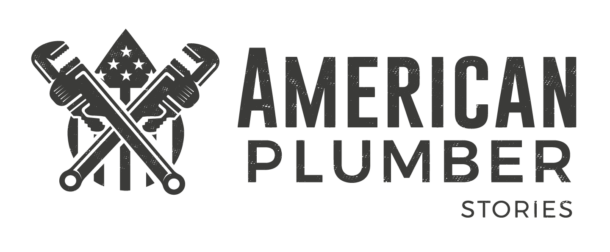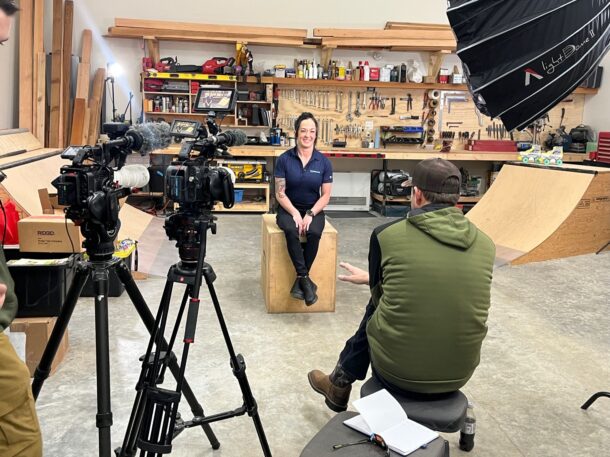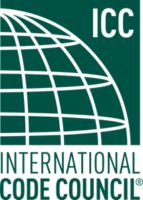Pfister® Faucets continues its celebrated docuseries, hosted by country music star and Army Reserve soldier Craig Morgan, spotlighting real-life stories of plumbers’ successes and the individual approaches that enabled them to achieve their dreams through a career in plumbing. Pfister® Faucets, a trailblazer in the plumbing industry, proudly announces the launch of the fifth season Read more
International Code Council


Pfister® Faucets continues its celebrated docuseries, hosted by country music star and Army Reserve soldier Craig Morgan, spotlighting real-life stories of plumbers’ successes and the individual approaches that enabled them to achieve their dreams through a career in plumbing.
Pfister® Faucets, a trailblazer in the plumbing industry, proudly announces the launch of the fifth season of their docuseries, American Plumber Stories. Over the past four seasons, this series has captivated audiences nationwide, showcasing the inspiring stories of plumbers who have overcome challenges to pursue their dreams in the plumbing trade.
Season 5 will present perspectives from plumbing experts in Australia, Alaska, Canada, Hawaii, and California, shedding light on the common challenges faced by plumbers worldwide. For the first time, the show has ventured outside the United States, creating great excitement about reaching an international audience—especially the next generation of plumbers.

Craig Morgan Returns for Season 5
Country music star and Army Reserve soldier Craig Morgan will return as the show’s charismatic host. Craig’s authentic passion and profound connection to the stories of tradespeople make him the ideal guide on this journey of discovery and inspiration.
“This year, Pfister’s American Plumber Stories is heading to my second home state of Alaska and beyond, and five seasons in, it remains an honor to share these stories of inspiring men and women on the frontline of the worldwide plumbing trade,” Craig Morgan shared.
Strong Alliance Partners and New Partnerships
Three new partners joined forces with American Plumber Stories for Season 5. The International Code Council, NIBCO and AprilAire will help expand the reach of the series to their sizable audiences in the US and around the world. They are joining the ranks of industry leaders RIDGID, Cintas, Oatey, and the PHCC in this important mission.
“NIBCO partnering with American Plumber Stories was a natural fit, as we are committed to supporting and elevating the plumbing industry,” said Ashley Martin, president and COO, NIBCO. “The U.S. is in critical need of the next generation of plumbers. This show is helping to engage young men and women in an authentic way to help change the perception and inspire successful and fulfilling careers in the plumbing trades.”
Beyond the Boundaries
Season 5 tracks down some interesting plumbers around the world.
- Maui–Arecently retired plumber lost his house and everything he owned in the Lahaina fire disaster. The set-back motivates his son Raymond to recruit the next generation of plumbers to help build Lahaina back.
- Australia– Martin is the “Crocodile Dundee” of the plumbing industry in Tasmania. He specializes in servicing remote locations that he reaches by helicopter and small “bush” planes.
- Alaska– In this episode we explore the beauty of Alaska and what it’s like for Bill to work as a plumber in an extreme climate.
- Vancouver Island, B.C.– This episode tells the inspirational story of Mary Anne who employs an all-female team of plumbers. Her 100K+ social media followers know her as @the_ladyplumber. Discover why she is a role model to tradeswomen.
- Salinas, CA– Plumber Instructor Jorge helps rehabilitate inmates by teaching them the plumbing trade in the Soledad State Prison. We have an open discussion with the warden on why this approach works so well.
- Victorville, CA– Meet the Motherflushers. They are young and passionate about plumbing and have changed the perception via social media– well beyond the borders of the United States.

For more information and to watch the new episodes of American Plumber Stories, please visit www.americanplumberstories.com.
Interested plumbers who would like to share their own story can do so here: www.americanplumberstories.com/pages/i-am-an-american-plumber.
Stay Connected
YouTube.com/c/AmericanPlumberStories
Instagram.com/AmericanPlumberStories
Facebook.com/AmericanPlumberStories
Linkedin.com/showcase/American-Plumber-Stories
TikTok.com/@AmericanPlumberStories
Subscribe to Email and Text Message Alerts www.americanplumberstories.com/pages/subscribe

Viega LLC manager Daniel Rademacher has won the PMG Leadership Award from the International Code Council (ICC) for his work in training and educating plumbing professionals around the world. Rademacher, who is the Trades Education Network (VTEN) Program Manager for Viega, was given the award at the ICC’s annual meeting Sept. 18-28 in Pittsburgh, Pa Read more
Viega LLC manager Daniel Rademacher has won the PMG Leadership Award from the International Code Council (ICC) for his work in training and educating plumbing professionals around the world.
Rademacher, who is the Trades Education Network (VTEN) Program Manager for Viega, was given the award at the ICC’s annual meeting Sept. 18-28 in Pittsburgh, Pa. The award is given each year to an individual or organization for exceptional service to the plumbing, mechanical, fuel gas and swimming pool/spa (PMG) industry.
“Dan’s passion for providing relevant and engaging learning opportunities so that plumbing professionals can achieve their career goals, no matter where they are located, is unmatched,” the ICC stated.

“I’m humbled to receive this award from the ICC, an institution which has done so much to advance plumbing and promote the well-being of people around the world,” Rademacher said. “And I’m proud to be able to introduce safe plumbing practices where they are needed most.”
Rademacher directs the Viega Trades Education Network, which partners with trade schools to provide tools, lessons and training to help educate future trades professionals.
This is only the latest industry honor for Rademacher. Last year, he was elected vice president of the board of directors of the American Society of Sanitary Engineering – International. In 2019, he won a World Plumbing Council Education and Training Scholarship to travel to Rwanda for the purpose of developing and contributing further plumbing industry knowledge. Also, he was the International Association of Plumbing and Mechanical Officials (IAPMO) Industry Person of the Year in 2014.
He has 30 years of experience in the industry and is an accomplished instructor. He is certified as a plumbing/mechanical inspector and plans examiner by the IAPMO. He has extensive experience using, implementing and interpreting the Uniform Plumbing Code, the Uniform Mechanical Code, International Plumbing Code, International Mechanical Code and International Fuel Gas Code.

The campaign encourages implementation of the most up-to-date energy codes to reduce greenhouse gas emissions, increase energy efficiency, and enhance resiliency and safety The International Code Council – the leading global source of model codes and standards and building safety solutions – launched its “Code on a Mission” challenge today which aims to have over Read more
The campaign encourages implementation of the most up-to-date energy codes to reduce greenhouse gas emissions, increase energy efficiency, and enhance resiliency and safety
The International Code Council – the leading global source of model codes and standards and building safety solutions – launched its “Code on a Mission” challenge today which aims to have over a third of the U.S. population covered by the 2021 International Energy Conservation Code (IECC) by the end of 2023. To make this a reality, the Code Council is challenging the building industry and communities alike to update their building energy codes to meet or exceed the requirements of the 2021 IECC. Already industry leaders like Architecture 2030, the Institute for Market Transformation (IMT), Energy Efficient Codes Coalition (EECC), Northeast Energy Efficiency Partnerships (NEEP), National Electrical Manufacturers Association (NEMA) and Responsible Energy Codes Alliance (RECA) have shown their support for the initiative.

As communities race to reduce their greenhouse gas (GHG) emissions and increase energy efficiency, modern and innovative energy codes are essential. Recognizing the increasing need for impactful tools and resources, the 2021 IECC incorporates significant improvements for both residential and commercial buildings over the 2018 edition including:
- Increased insulation requirements and reduced fenestration U-factors and solar heat gain coefficients for both residential and commercial provisions.
- New mechanical ventilation testing and exterior lighting requirements for residential buildings.
- Lower ERI path values and additional energy reduction requirements in the residential requirements.
- Updated mechanical equipment efficiency requirements, new provisions for data centers and plant growth lighting, and increased lighting efficacy and decreased lighting power density requirements for commercial buildings.
- Zero energy appendices for jurisdictions wishing to implement zero energy building requirements today.
On July 21, the U.S. Department of Energy (DOE) released its final determination finding that the residential provisions of the 2021 IECC provide a 9.4% improvement in energy use and an 8.7% improvement in carbon emissions over the 2018 IECC, saving homeowners an average of $2,320 over the life of a typical mortgage. Since 2006, the IECC has provided an approximately 40% improvement in energy efficiency, meaning that residents in states and cities on older IECC editions would see far greater savings. The Department has also released data on energy, cost and GHG reductions each state and many cities could achieve by adopting the 2021 IECC, which are available here.
With the zero-energy building goals set forth by the U.S. Administration for new construction by 2030 and 2050 for all buildings, it is imperative that national, state and local governments incorporate energy codes to meet their GHG reduction objectives and align with these goals. Additionally, states and localities have set either GHG reduction goals or established zero-energy building targets that will require an alignment with modern energy codes.
Currently, per the U.S. Department of Energy (DOE) and the Pacific Northwest National Laboratory, 14 states have adopted codes that are at least 20% less efficient than the current IECC while another ten states have no statewide energy code adopted.
“Reducing society’s GHG emissions is no longer a ‘nice-to-do’ but rather a critical necessity, and governments, communities and the building industry as a whole are increasingly recognizing the contributions of buildings,” said Ryan Colker, Vice President of Innovation at the International Code Council. “Luckily, modern and innovative model building codes like the IECC have already been developed to significantly curb emissions and help achieve zero-energy buildings. We urge national, state and local governments to accept our challenge and members of the building industry to support code updates.”
Please visit iccsafe.org/iecc-on-a-mission:
- For more information on the “Code on a Mission” campaign.
- To learn more about the benefits of the adoption and implementation of the 2021.
- To report an adoption of a code that meets or exceeds the 2021 IECC.
- To become a mission supporter or to access adoption resources.
About the International Code Council
The International Code Council is the leading global source of model codes and standards and building safety solutions. Code Council codes, standards and solutions are used to ensure safe, affordable and sustainable communities and buildings worldwide.
Companies and building managers can access free resources at the Code Council’s Coronavirus Response Center. Washington, D.C. – As local and state governments are beginning a phased reopening of their economies, the International Code Council has compiled a guide of safety precautions and considerations for businesses looking to resume in-office activities. Acting as an aggregate Read more
Companies and building managers can access free resources at the Code Council’s Coronavirus Response Center.
Washington, D.C. – As local and state governments are beginning a phased reopening of their economies, the International Code Council has compiled a guide of safety precautions and considerations for businesses looking to resume in-office activities. Acting as an aggregate information hub, the Code Council’s Coronavirus Response Center offers relevant information for building professionals and potential occupants to understand the impact the pandemic has had on the industry, as well as for companies who are currently creating plans and strategies to move back into their offices.
Ahead of reopening efforts, the Code Council has made it a priority to educate businesses, office managers and building safety professionals on an important but often-overlooked safety precaution – preparing an office building for re-occupancy. With many buildings reducing or turning off normal system operations during stay-at-home orders, it is critical to properly inspect and prepare a vacant building ahead of resuming regular activities. Without proper preparation and maintenance, the building may pose unrealized hazards to incoming occupants, whether from a heating, ventilation, and air conditioning (HVAC) or plumbing system to a powerless carbon monoxide detector.
Due to the wide range of aspects necessary for reopening a previously unoccupied building, the Code Council’s Coronavirus Response Center covers topics include:
- Addressing any temporary changes needed to building access and exit patterns to accommodate temporary reopening protocols such as employee health screenings, disposal of PPE, or any areas specifically designated for decontamination.
- Visually inspecting and testing the operation of building entrances and exits including doors, revolving doors, and garage doors for proper operation and ensure they are free from obstructions.
- If a building’s water distribution system has been shut down or seen reduced flow, flushing the pipe system with clean, potable water to remove any unwanted debris.
- Facilitating adequate physical distancing protocols, and considerations for revising maximum occupant loads for all buildings and spaces to accommodate 75 gross SF/occupant.
- Closing common areas where personnel are likely to congregate and interact or enforcing strict physical distancing protocols.
- Guidance on disinfecting communal areas from FEMA and the CDC
“COVID-19 has had an unprecedented impact on our society, both economically and socially. As we continue to learn to navigate the new normal and discover what that actually entails, having easy access to information on topics like how to properly prepare a vacant building for reoccupation is crucial, especially during reopening efforts,” said Dominic Sims, CBO and CEO, International Code Council.
Access to the Code Council’s Coronavirus Response Center can be found here, while the full list of tips and considerations for reopening buildings can be found here.
Updated International Plumbing Code and International Mechanical Code enhance safety, and save time and resources Washington, D.C. – The International Code Council announced the release of its 2021 International Plumbing Code (IPC) and International Mechanical Code (IMC). Building codes play a significant role in maintaining safe and healthy communities – permitting more resilient, sustainable and livable Read more
Updated International Plumbing Code and International Mechanical Code enhance safety, and save time and resources
Washington, D.C. – The International Code Council announced the release of its 2021 International Plumbing Code (IPC) and International Mechanical Code (IMC). Building codes play a significant role in maintaining safe and healthy communities – permitting more resilient, sustainable and livable structures for generations to come.
The IPC and IMC are revised on a three-year cycle through the Code Council’s highly respected consensus code development process that draws upon the expertise of hundreds of plumbing, mechanical, building and safety experts from across North America. With updates every three years, building codes allow for ongoing consideration of new technologies and scientific understandings.
“It’s critical for our codes to adapt to new building practices, technologies and societal needs. Our 2021 IPC and IMC take these needs into consideration and aim to promote safety above all else,” said Code Council Chief Executive Officer Dominic Sims, CBO. “Construction is ever-evolving, and how we prepare trades professionals matters more now than ever.”
The IPC is a pragmatic, apolitical, and technology-based look at the code that gives me a much bigger toolbox to choose from,” says All Area Plumbing senior project executive Damon Premer, a featured guest on the ICC Pulse Podcast. “Instead of being restricted to one way of doing things, with the IPC I have options and I can customize to the best quality for that project. The IPC gives me code proven ways to accomplish things that other codes lack.”
International Plumbing Code
The IPC establishes safety standards for health, safety, property protection and public welfare by prescriptive and performance provisions for the design, construction, installation, quality of materials, location, operation and maintenance or use of plumbing equipment and systems. 2021 additions/updates include:
- Multiple-user toilet facilities to serve all genders are now permitted.
- Two new methods for relining/rehabilitation of existing sewers have been added.
- Accommodations for mounted rooftop solar panels over vent terminals have been added.
- CSA B805/ICC 805 Rainwater Harvesting Systems is now allowed as an alternative design method.
In 2019, the Code Council commissioned a comprehensive independent analysis of the costs and savings associated with building under the IPC. The study found that over a 12-year period, counties that used the IPC saved $38 billion in construction costs and emitted one million fewer tons of carbon dioxide. The savings that resulted from use of the IPC contributed to national efforts to improve housing affordability.
International Mechanical Code
The IMC establishes minimum requirements for mechanical systems using prescriptive and performance-related provisions. It is founded on broad-based principles that make possible the use of new materials and new mechanical designs. 2021 additions/updates include:
- Clothes dryer exhaust terminals are now required to be at least three (3) feet from any opening into a building.
- Polyurethane spray-applied foam on the exterior of ducts in attics and crawl spaces is now required to meet specific smoke and flame index limits.
- Fire and smoke dampers must now be provided with approved access for inspection and maintenance.
- Refrigerant tables now include new refrigerants.
The 2021 IPC and IMC are currently available for pre-order and will be widely available in print and digitally in March. Related provisions of the ICC A117.1-2017 Standard for Accessible and Usable Buildings and Facilities will be included as a resource in the 2021 IPC. To pre-order the 2021 IPC and IMC, visit:
